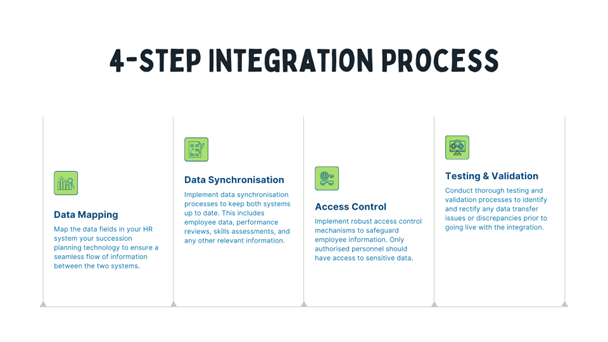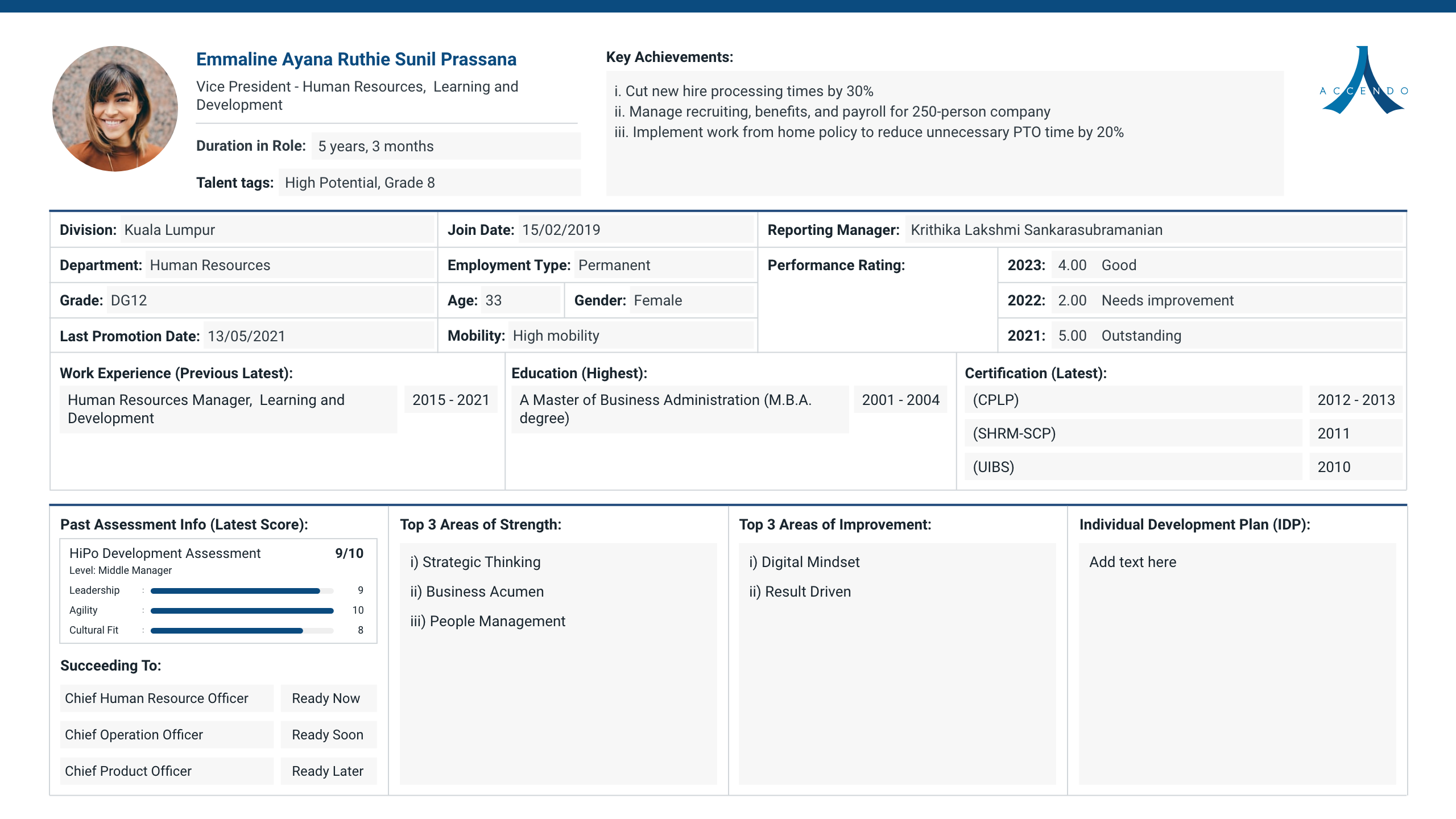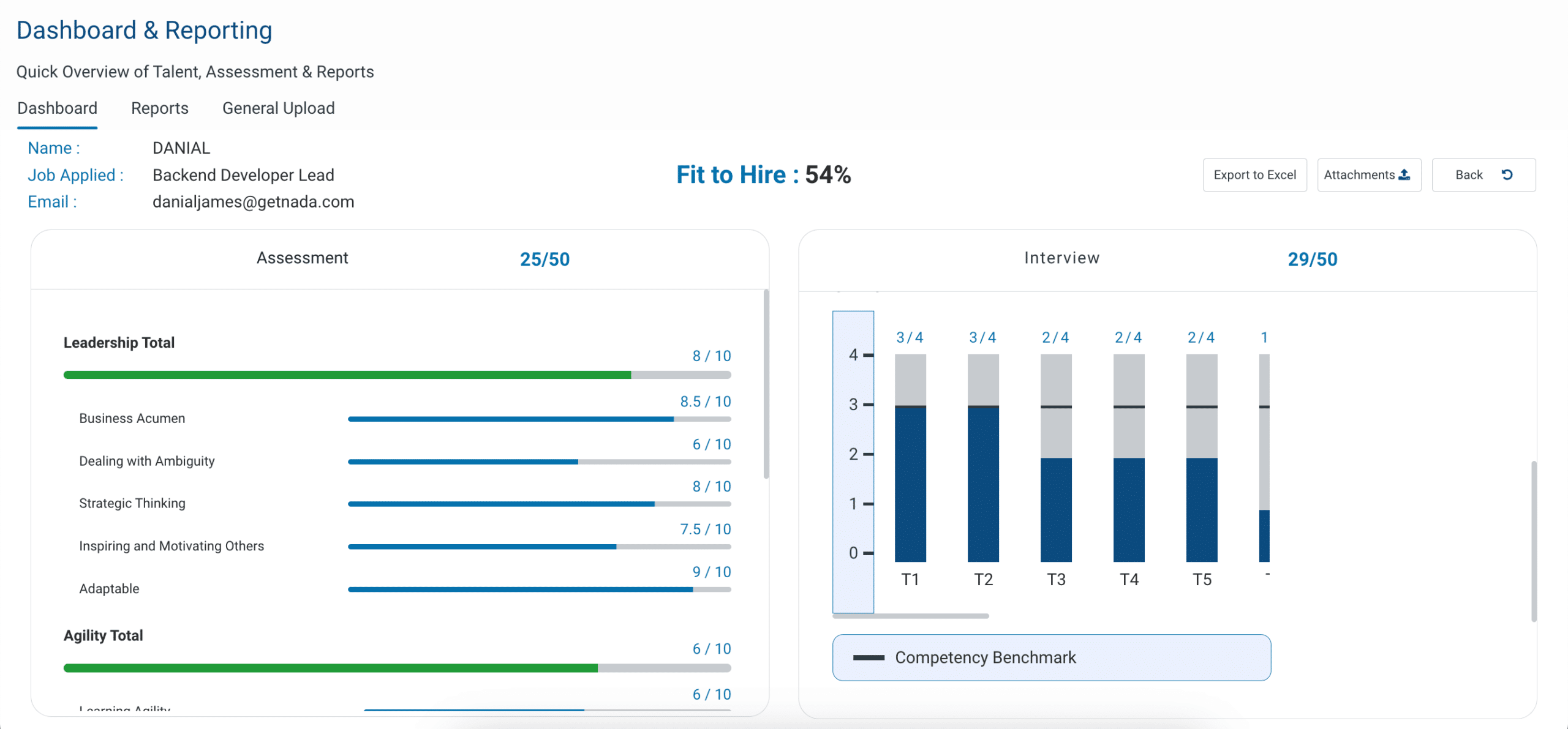
Succession planning is the process of identifying and developing future leaders and key talent within your organisation. But how can you leverage technology for succession planning? Our blog highlights the importance of succession planning technology, emphasising its benefits, and the integration of succession planning technology with HR systems, while providing guidance on how to choose the right tech platform. Additionally, our blog highlights the top three succession planning software for 2023.
Introduction
In an era marked by rapid technological advancements, changing demographics, and a workforce that keeps evolving, the significance of succession planning has never been more pronounced.
The traditional methods of identifying and nurturing future leaders fall notably short in tackling today’s business challenges. As a result, organisations are embracing technology to transform how they handle succession planning.
This blog will shed light on succession planning and its connection to modern technology. It will explore the benefits of using tech platforms for succession planning and guide you in selecting the right tech solution. Additionally, we will reveal the top three succession planning tools for 2023.
How Technology Plays a Role in Succession Planning
The integration of succession planning technology has brought about a significant transformation in the way organisations prepare for the future.
Unlike traditional methods, which were often manual and time-consuming, digital succession planning offers streamlined processes, enhanced precision, and the ability to adapt swiftly to changing business landscapes.
According to the report, The State of Succession Management 2019, respondents who self-identified as having effective succession management programs at their organisations tend to use technology to support their succession planning and management process.
Technology has also made it possible for organisations to comprehensively analyse employee data, skills, and potential, enabling them to identify and develop their next-generation leaders more effectively.
Some of the key features and capabilities of digital succession planning include:
- Data analytics – Succession planning platforms assess employees using data analytics, considering past performance, skills, training, and feedback for a holistic suitability evaluation.
- Talent pool identification – Technology platforms help to maintain a pool of potential leaders by identifying HiPo employees, tracking their development, and aiding career decisions.
- Customised development plans – Digital succession planning offers customised development plans to groom employees for leadership roles.
- Scenario planning – Technology platforms allow organisations to simulate different succession scenarios to evaluate the preparedness of potential successors.
- User-friendly interfaces – Modern platforms prioritise user-friendliness which eliminates barriers to succession planning and ensures that HR teams can use them effectively.
5 Benefits of Using a Tech Platform for Succession Planning
Succession planning is an ongoing, adaptive process that technology can greatly improve. With technology, you can access precise, timely, and actionable information, enabling you to place the most suitable individuals in key positions when needed, ultimately driving your organisation toward its goals effectively.
In this section, we explore the benefits of using tech platforms for succession planning and how they have transformed this essential business practice.
1. Improved accuracy and data-driven decision-making
Traditional succession planning often relies on subjective assessments and gut feelings. However, tech platforms leverage data analytics and algorithms to assess potential successors objectively.
Tech platforms can analyse a wider range of data points, including performance metrics, skills, and experience to identify the most suitable candidates for key roles. This enables organisations to make more informed decisions based on concrete evidence rather than personal biases, thus reducing the risk of making suboptimal choices.
2. Enhanced visibility and accessibility
Tech platforms provide enhanced visibility and accessibility when it comes to succession planning. They allow organisations to maintain a centralised database of information related to potential successors, facilitating better coordination and transparency in the digital succession planning process.
At the same time, the enhanced visibility enables decision-makers to easily assess the status of succession plans, track progress, and identify gaps. This gives organisations the ability to proactively manage their talent pipeline and respond to changing business needs more effectively.
3. Streamlined communication and collaboration

Effective succession planning requires collaboration among various stakeholders, including HR professionals, department heads, and senior leadership. Tech platforms streamline communication and collaboration by providing a common platform for all relevant parties to share information, insights, and feedback.
Features such as real-time updates, notifications, and collaborative tools within these platforms enable stakeholders to work together seamlessly. All these ensure that succession planning is a team effort.
4. Scalability and flexibility
Tech platforms offer scalability and flexibility, allowing organisations to adapt their digital succession planning strategies as they grow or as business conditions change. In other words, these platforms are built to accommodate evolving needs.
Scalability allows organisations to easily add more candidates, roles, or departments to their succession planning process without major disruptions. On the other hand, flexibility enables organisations to customise their succession planning models to fit their unique requirements and organisational culture, ensuring that the approach remains relevant and effective over time.
5. Cost-effectiveness and resource optimisation
Effective use of resources is crucial for any organisation. Tech platforms for succession planning can lead to cost savings and resource optimisation. By automating various aspects of the process, organisations can reduce administrative overhead and allocate resources more efficiently.
Furthermore, these platforms enable organisations to identify HiPo employees within their existing talent pool, thus reducing the need for costly external recruitment or talent acquisition efforts. Not only does this save money but it also promotes a culture of internal growth and development.
How to Choose the Right Tech Platform for Your Succession Planning Needs
In today’s digital age, technology can greatly streamline and enhance your digital succession planning process. However, the variety of tech platforms available can be overwhelming. Selecting the right tech platform is critical in ensuring the long-term success and sustainability of your organisation.
To help you make an informed decision, we will guide you through the essential steps in choosing the right tech platform for your succession planning needs.
More than half (54%) of respondents who work at organisations with effective programs use formal assessment tools to gauge leadership capabilities, while only 36% of organisations with less effective programs do so.
Assess your organisation’s specific requirements
The first and most crucial step is to thoroughly assess your organisation’s unique requirements. This assessment should encompass various aspects, including:
- Company size and structure – Are you a small startup, a mid-sized company, or a large multinational corporation? The platform you choose should align with the scale and complexity of your business.
- Succession planning objectives – Are you primarily focused on leadership continuity, skill development, or a combination of both? Understanding your objectives will help you select a platform that caters to your specific needs or goals.
- Data and reporting needs – Succession planning generates a wealth of data. Determine the level of data analysis and reporting your organisation requires. This will influence your choice of a platform that offers robust analytics capabilities.
- Integration with existing systems – Assess the compatibility of the platform with your existing HR and talent management systems. Seamless integration can save time and resources while ensuring data accuracy.
- User accessibility – Consider who will be using the platform. Will it be accessible to your HR teams, managers, employees, or all the above? User-friendliness and accessibility are vital for effective adoption.
Key factors to consider
Once you have assessed your organisation’s specific requirements, it is time to dive into the key factors to consider when evaluating potential tech platforms for succession planning.
- Features and functionality – Look for a platform that offers a comprehensive set of features that align with your digital succession planning goals. This may include talent assessment tools, talent profiling, development planning, and more.
- Scalability – Ensure the platform can grow with your organisation. Scalability is essential to accommodate the changes in your workforce and leadership needs over time.
- Data security and compliance – Data security and compliance with relevant regulations (such as GDPR, HIPAA, or PDPA) should be non-negotiable. Your platform should protect sensitive employee data.
- User experience – A user-friendly interface and intuitive navigation are essential to encourage adoption and engagement among users.
- Vendor reputation and support – Research the vendor’s reputation in the industry and their track record of providing reliable customer support and updates.
- Cost – Consider the total cost of ownership, including licensing fees, implementation costs, and ongoing maintenance. This ensures that the platform is aligned with your budget constraints.
Common pitfalls to avoid
In your quest to choose the right tech platform for succession planning, be mindful of the common pitfalls that can derail and delay the selection process.
- Rushed decisions – Avoid the temptation to rush the decision-making process. Take the time to thoroughly evaluate your options and conduct pilot tests if possible.
- Ignoring user feedback – Don’t disregard the input of end-users. Gather feedback from your HR teams, managers, and employees who will be using the platform to ensure it meets their needs.
- Overlooking future needs – Your organisation will continue to evolve, and so will your digital succession planning requirements. Ensure the chosen platform is flexible enough to adapt to your future needs.
- Focusing solely on cost – While cost is important, prioritising it over functionality and quality may lead to long-term issues. Consider the value the platform provides rather than just its price tag.
Remember, the decision you make will have a significant impact on the future leadership and success of your organisation, so choose wisely.
Integrating Tech-Enabled Succession Planning with HR Systems
The integration of succession planning technology with HR systems represents a strategic alignment that can significantly enhance an organisation’s talent management efforts. Here are some key reasons why integration is essential:
- Holistic talent management – Integrating succession planning platforms with your HR systems provides you with a comprehensive view of your talent pool. This holistic perspective allows for better identification of your HiPo employees, skill gaps, and development opportunities.
- Data consistency – Integration ensures data is consistent and up to date while minimising the risk of errors and discrepancies in employee records. This makes it easier for your HR teams to make informed talent decisions.
- Efficiency and automation – Integrated systems can automate many aspects of succession planning. This streamlines processes, reduces administrative overhead, and frees up your HR teams to focus on strategic tasks.
- Real-time insights – Integration allows for real-time access to critical talent data, enabling your organisation to respond quickly to changing circumstances, such as sudden leadership vacancies or emerging skill shortages.
Almost 60% of leaders agree that the risk of not having a succession plan is high, and 48% of leaders understand that succession planning has significant cultural, operational, and financial benefits.

Now that you understand its importance, here are the steps to how the integration process works.

Top 3 Succession Planning Software in 2023
Discover the three powerful succession planning software designed to revolutionise talent management. These tools can seamlessly integrate with your HR systems, offer comprehensive talent profiling, and are ideal for identifying and developing future leaders. Let us look at each succession planning tool in more detail.
Accendo’s Succession Planning Software
Accendo’s Succession Planning software includes an array of various talent assessment tools, an extensive library of success profiles, and a matching algorithm. This combination accelerates the talent identification process, providing faster, cost-efficient, and highly accurate insights. The result is a strong leadership pipeline that drives business growth.
Here are some noteworthy features of Accendo’s Succession Planning tool.
Holistic talent evaluation
Our innovative method utilises diverse data points to optimise talent identification, mitigate biases, and ensure role compatibility.

An intuitive TalentPulse dashboard provides organisations with the capability to identify successors for key roles using comprehensive assessments. The platform provides insights into strengths, and gaps, and streamlines talent review meetings. This aids organisations in building informed succession strategies.
Extensive global success profiles
With over 30 years of dedicated research, Accendo offers an extensive database featuring more than 3,000 globally benchmarked success profiles. These profiles facilitate precise assessments of candidates based on universally recognised benchmarks for job excellence.

This invaluable resource enables organisations to create customised success profiles that define the essential qualities and competencies required for vital roles within a wide range of industries and organisational hierarchies. The dynamic database is continuously updated, incorporating 20 frameworks across 16 industries to ensure alignment with the evolving demands of the job market.
Quick yet reliable decision-making
In moments where timely decisions are crucial, reliability becomes paramount. Our validated algorithms, honed through years of advisory expertise, provide organisations with the confidence to identify capable successors.

Accendo’s Succession Planning tool enables organisations to enhance and deepen their talent search, utilising a wealth of data to assess capabilities and foster data-driven discussions that shape future planning.
Consolidated candidate report outputs
TalentPulse offers extensive reporting capabilities, including the Developmental Report (which highlights assessment results and growth potential) and the Executive Report (which supplements findings with interview insights).

These valuable reports are instrumental in evaluating candidates, identifying areas for improvement, and making informed decisions regarding talent development and succession plan strategies.
Cornerstone OnDemand
Cornerstone OnDemand is a talent management suite that offers succession planning templates and other functionalities that are designed to help organisations identify and develop their future leaders from within. Here are some key features and functionalities that you might expect from their succession planning tool:
- Talent identification – Allows organisations to identify HiPo employees and key positions that require succession planning. It helps in creating a talent pool of potential successors.
- Skills gap analysis – Helps in assessing the skills, gaps, development needs, and competencies of potential successors in comparison to the requirements of the roles they might step into.
- Development planning – Creates individual development plans for employees in the talent pool, including training, mentoring, and coaching opportunities to prepare them for leadership roles.
- Data analytics – Tracks the progress of succession planning efforts while measuring the effectiveness of development initiatives to enable data-driven decisions.
- Integration – Integrates with other talent management modules to ensure succession planning is aligned with HR processes such as performance management and learning and development.
- Reporting and insights – Provide reporting capabilities to help organisations visualise the status of their succession planning efforts and gain insights into the readiness of potential successors.
PeopleFluent
PeopleFluent is an HR and PAYROLL management software solutions provider that offers a succession planning tool as part of its suite. Its succession planning tool is designed to assist organisations in identifying and developing HiPo employees to fill key leadership roles within the company. Here are some key features and functionalities that are included in their succession planning tool:
- Talent identification – Identifies individuals with the skills, potential, and qualifications to assume future leadership roles, including performance assessment, competencies, and career aspirations.
- Succession planning – Creates and manages succession plans for critical positions, including identifying potential successors, defining development plans, and tracking progress.
- Performance management – Allows organisations to link employee performance data with succession planning to ensure that high performers are considered for future leadership roles.
- Development planning – Assists in creating individual development plans for employees identified as HiPo successors, including training, mentorship, and skill development initiatives.
- Integration – Integrates with other HR systems to help streamline data management and ensures that succession planning aligns with broader HR strategies.
- Reporting and analytics – Provide reporting and analytics capabilities to track the effectiveness of succession planning efforts, identify gaps, and make data-driven decisions.
Best Practices for Tech-Enabled Succession Planning
Now that you understand the pivotal role of succession planning technology, its benefits, and how to select the most suitable tech platform, let’s delve into the best practices that will ensure your organisation’s success in this critical area.
According to a SHRM survey, 56% of organisations don’t have a succession plan. There’s more to succession planning than simply naming a person who will step into a C-suite position.
1. Implementing technology-driven succession planning effectively
This step requires you to strategically select software and tools that align with your organisation’s needs. These tools may include talent management systems, data analytics, AI assessments, and collaborative platforms. Involve your HR teams, senior management, and IT in the process, create a roadmap for technology adoption, and regularly assess and adjust the technology’s performance.
2. Developing a comprehensive succession plan
Use technology to gather and analyse data on your employees’ skills, performance, potential, and career aspirations. With this, you can identify potential successors for executive and mid-level management positions. Leverage technology for talent mapping, gap analysis, and assessing candidates’ readiness. Encourage cross-functional training and maintain a flexible plan to adapt to change in business strategy and market dynamics.
3. Training and upskilling HR and management teams
Invest in training and upskilling for your HR teams and management teams to effectively leverage technology for succession planning. This includes:
- Providing workshops, webinars, and certifications
- Fostering data analysis proficiency in HR for identifying successors
- Coaching HiPo employees within the management
- Educating all stakeholders about the importance of succession planning and technology’s role in organisational success
4. Monitoring and adapting to changing needs
Continuously monitor and adapt your succession plan by utilising technology to track potential successors’ development, implementing performance metrics, and staying informed about changes in the business environment. Be prepared to revise your plan as needed, incorporating stakeholder feedback and addressing any challenges.
Success Story in Tech-Enabled Succession Planning

Success Starts Now: Take the First Step with Succession Planning
Ready to take charge of your organisation’s future?
Succession planning is the key to unlocking your talent’s true potential, ensuring a smooth and successful transition to new leadership. With Accendo’s Succession Planning solution, you’ll have the power to identify and nurture emerging leaders, making your company resilient to any unforeseen challenges.

Frequently Asked Questions (FAQs)
How can technology help with succession planning?
Technology can aid succession planning by providing robust data analytics and automation tools. It can help identify potential successors by analysing employee performance data and skill sets, making the selection process more objective and efficient.
What is digital succession planning?
Digital succession planning is the use of technology to streamline and modernise the succession planning process. It involves using software and digital tools to identify, develop, and track potential successors within an organisation, making the process more dynamic and data driven.
How to choose the right tech platform for your succession planning needs?
Start by considering your organisation’s specific needs and goals. Look for a platform that offers user-friendly interfaces, scalability, integration capabilities with existing systems, and strong security features. Additionally, ensure that it aligns with your budget and provides adequate support and training.
What are the benefits of using a tech platform for succession planning?
Using a tech platform for succession planning offers several benefits, including improved visibility into talent pipelines, quicker identification of potential leaders, better talent development, and the ability to make data-driven decisions. It can also enhance collaboration and transparency within the organisation.
What are the key features to look for in a succession planning tech platform?
The key features include robust reporting and analytics, customisable workflows, talent profiling, goal setting, and the ability to create development plans. Integration with performance management and learning management systems can also be valuable.
How can a tech platform enhance succession planning?
A tech platform can enhance succession planning by automating administrative tasks, providing real-time insights into talent development, and facilitating communication and collaboration among stakeholders. This allows organisations to proactively identify and groom future leaders.
Can a tech platform for succession planning be integrated with other HR software systems?
Yes, it can be integrated with other HR software systems, such as Human Resources Information Systems (HRIS), performance management, and learning management systems. This integration ensures seamless data flow and a more holistic approach to talent management within the organisation.
Page Contents







